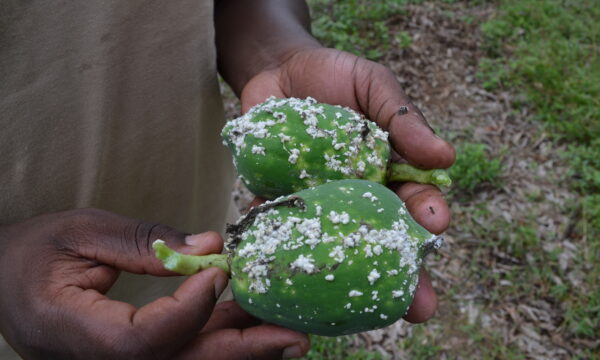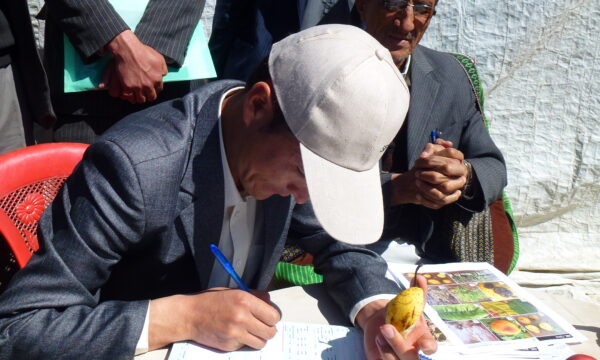
Example of Ecological engineering in Vietnam (Photo credit: Dr HV Chien)
The rice ecosystems are inhabited by more than 100 species of insects. Twenty of them can cause potential economic losses. With the change in the climatic factors and modern cultural practices adopted for production a drastic change has been caused in the pest scenario in the recent past. Besides stem borer, gall midge, brown plant hopper and green leafhopper which were the major problems in past, several other relatively minor pests such as leaf folder, armyworms, cut worms etc. have gained importance. In a study conducted by the International Rice Research Institute (IRRI), it was found that, on average, farmers lose 37% of their rice yield to pests and diseases, and that these losses can range between 24% and 41% depending on the production situation (http://irri.org). All the pests are generally kept under check by their natural enemies (parasitoids and predators) by feeding on them. The food web of their relationships prevents the explosion of their populations and keeps them under economic thresholds mimimising the pesticide use.
What is Ecological engineering?
Ecological engineering is the integration of ecology with engineering. It is an approach to the restore the ecosystems that have been substantially disturbed by human activities such as environmental pollution, climate changes or land disturbance and the development of new sustainable ecosystems that have both human and ecological values. It not only involves conserving these natural inhabitants but also refraining from using insecticides in the early crop stage.
The concept was introduced in rice farming in China in 2008, and later on in Vietnam and Thailand. More recently, the Philippines also launched a project. Flowers or flower bearing crops alternatively are grown in bunds along with the rice crop to provide food and habitat for the parasitoids and predators which then lays their eggs on the insect populations in the rice fields. This gradually brings down the carryover of the pest populations and also the insecticidal sprays are reduced. In India, it can be other supplementary crops like sesame, soy beans or vegetables which can increase farmer’s income.
The National Institute of Plant Health Management (NIPHM), India has also recently introduced this approach among farmers to aid them to maintain the biodiversity and keep pests under control while at the same time maintaining the rice eco-system. NIPHM is popularizing these concepts and is committed to create a pool of master trainers who in turn are expected to popularize AESA based Plant Health Management among farmers.
The adoption of this technology requires a community approach to be taken up by the farming community which will not only suppress the pest population but also enhances the soil health through organic bio-fertilizer utility. In the state of Kerala, India, Plant health clinics launched under the Crop Health Management scheme are also now promoting various sustainable technologies other than Ecological Engineering such as Agro Ecosystem Analysis, Onfarm production of biocontrol agents etc. along with regular pest and diseases diagnosis and surveillance based advisories to ensure that Plant Health Clinics are acting as a total solution to strengthen the whole plant health system.
Challenges in Implementation
The biggest challenge in its adoption is to motivate the farmers to adopt these concepts rather than looking for quick knock down by chemical sprays, raising awareness among them to stop the routine sprays and ask them to enrich the bunds with necatar-rich flower crops. As the scenario is worse in the developing countries than in the developed countries there is an urgent need to harmonise the countries guidelines on pesticide use and distribution to conform with the FAO Code of Conducts.
Most predators and parasitoids are hymenopterans and thus insecticides toxic to bees and hymenopterans in general needs to be avoided/reduced. These include neonicotinoids and pyrethroids. Recently neonicotinoids are established to have direct links with bees and pollination services. Similar effects on biological control services provided by the parasitoids are expected.
Click on the links below to get more details.
http://www.krishijagran.com/news/2015/06/Establishment-of-Plant-health-clinic-in-Kerala
http://www.dw.com/en/vietnam-uses-ecological-engineering-to-save-rice/a-17571615
1 Comment
Leave a Reply
Related News & Blogs
Parasitic wasps play pivotal role in Kenya’s papaya mealybug control
Papaya mealybug (Paracoccus marginatus) is a devastating papaya pest. It impacts many countries in East and West Africa. Infestations can result in significant economic losses, posing a threat to the livelihoods of smallholder farmers. On average, the…
15 April 2024





Excellent article